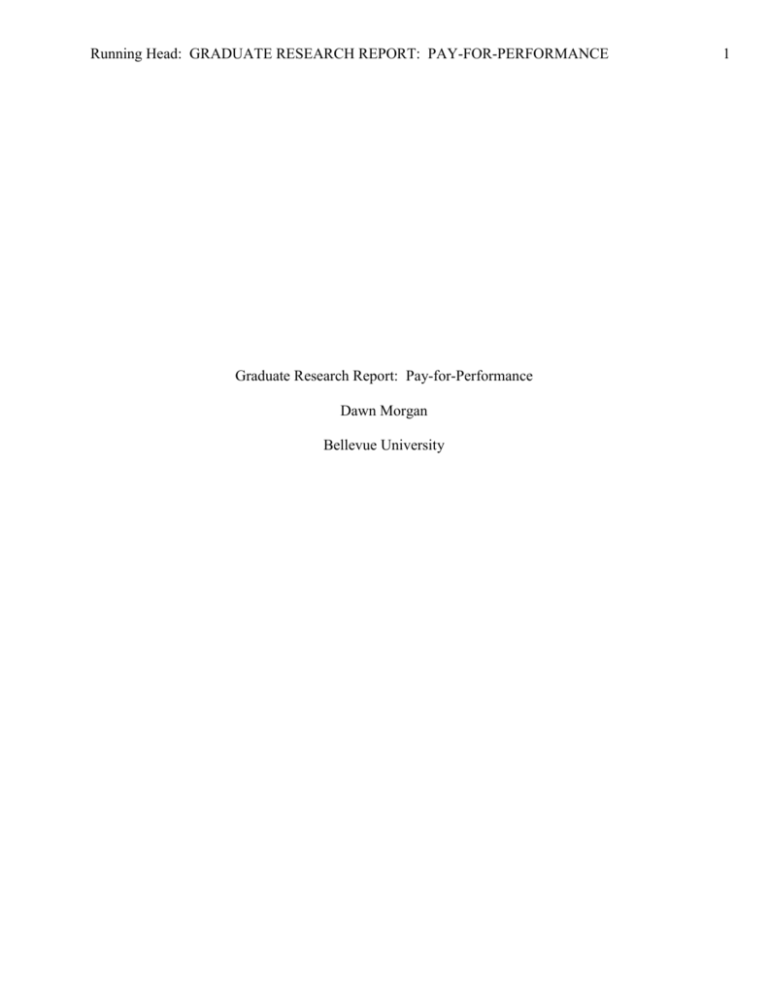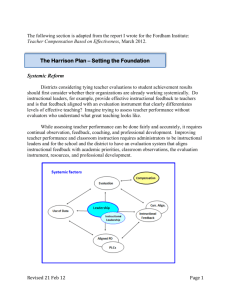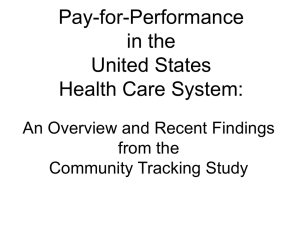Dawn Morgan BA 636 Graduate Research Report 1
advertisement

Running Head: GRADUATE RESEARCH REPORT: PAY-FOR-PERFORMANCE Graduate Research Report: Pay-for-Performance Dawn Morgan Bellevue University 1 GRADUATE RESEARCH REPORT: PAY-FOR-PERFORMANCE Abstract A pay-for-performance pay system is based on the concept of employees being paid for their individual productivity. While there are many opinions weighing in on the success of this type of pay system or not, this paper will focus on the positive aspects. Remaining objective when measuring performance and determining which specific performance factors to evaluate are two ways to ensure the success of pay-for-performance pay systems. Whether the organization is the federal government, a factory, a law firm, or a nursing home, a solid pay-for-performance plan can help increase employee productivity while focusing on contributing to the organization’s mission, values, and strategies. 2 GRADUATE RESEARCH REPORT: PAY-FOR-PERFORMANCE Graduate Research Report Pay-for-Performance Pay-for-performance pay systems appeared to be fairly cut and dried on the surface. People are paid for how well they perform, correct? According to many authors it may not be so simple. Linking an employee’s pay to the measurement of their performance takes a lot of forethought and execution. A pay-for-performance plan must be completely objective and specifically measurable. This type of pay system is not limited to one specific type of organization that can be beneficial to route almost any type of organization, from a manufacturing environment to a medical hospital. There must be a broad spectrum of performance factors looked at and not just the financial outcome for the company: “The idea is to marry the fortunes of the employee to the performance of the company" (Wiscombe, 2001, p. 30). In attempting to explain this, several different perspectives have been brought into this paper. First, taking a look at the federal government’s general schedule for civilian pay, job satisfaction and organizational commitment are seen as relating to performance. In the next section, performance management and compensation management are looked at in terms of needing to work together in order to establish a good pay-for-performance system, in addition to the need for alignment with organizational strategies and the employees level of motivation affecting their compensation. Additionally, pay-for-performance programs in healthcare environments are shown to have an impact on improving the quality of the performance of healthcare providers. Finally, the topic of distributive justice deserves contemplation. Distributive justice, or the perception of fairness in terms of pay, is based on objective performance measurements and effective performance communication. To begin, we look at how 3 GRADUATE RESEARCH REPORT: PAY-FOR-PERFORMANCE a pay-for-performance pay system could effectively replace the federal government’s current civilian pay schedule. Federal Government The General Schedule (GS) is the name of the civilian pay schedule under the federal government. The current schedule in use is over 60 years old and does not really fit in with the changes in today’s workforce (Campbell, 2007). In my own experience, what I’ve seen with this pay schedule are employees who are paid by position and not by the amount or quality of the work they perform. Many employees tend to hold the same position for years, never increasing or improving the quantity of work performed or the value of it, and definitely not appearing to be committed to the organization. According to James Campbell III in his 2007 paper on his study regarding the lack of pay-for-performance pay systems in the federal government, the Department of Defense is significantly behind the private sector in recognizing how important it is to pay people based on their performance versus being paid according to their position through a salary scale. The problem, as Campbell sees it, is there are no incentives for an employee to work on improving their performance when there’s no reward system in place. According to a 2002 survey which he references in his paper, there has been a decline in the performance of civil servants which could indicate a lack of organizational commitment and one of the purposes for Campbell’s study was to examine whether pay performance can actually help increase employee performance (2007). Employees at a chosen research and development lab used to be rated under the old GS system, but under the new pay-for-performance plan the effect of time, feedback, and perception factors were measured (Campbell, 2007). Campbell (2007) had several hypotheses in regards the outcome of this study, but the ones which stood out the most to me were his thoughts of how 4 GRADUATE RESEARCH REPORT: PAY-FOR-PERFORMANCE job satisfaction would have a positive effect on job performance in addition to a higher level of organizational commitment. Campbell feels that if the federal government adopts a pay-forperformance pay system they will be much more competitive with the private sector and he applies the expectancy theory of Vroom to help make his point that employees who make an effort to work towards a specific goal because there will be a specific reward can lead to increased performance (Campbell, 2007). The outcome of this study in general terms showed job satisfaction was directly related to job performance and in turn organizational commitment. The motivation behind being paid based on performance can directly impact that level of performance. Other authors look at the importance of integrating compensation of performance management and the applicability of individual goals to the organizational strategy. Integrated Compensation and Performance Management According to Lynn Summers in his 2005 paper, pay-for-performance is extremely logical: people are paid based on the performance which motivates them to perform better. The problems he sees with it however, is that people can’t accurately be paid for their performance if that performance is not correctly measured and performance measurement will not work if there isn’t a proper pay incentive involved (Summers, 2005). Summers (2005) provides a very good analogy in his article: think of performance management as a vehicle which takes you places and compensation management as the gas which is the motivational requirement to help get you there. This is a very good analogy because it shows you how important it is for the two aspects to work together to be successful. David Bisson (2001) also suggests that for pay-for-performance systems to work there must be competitive pay for the various levels of performance, meaning high levels of 5 GRADUATE RESEARCH REPORT: PAY-FOR-PERFORMANCE performance will be rewarded more significantly and employees will face the risk of lower pay for lower performance. This relates to motivation: employees will be motivated to work harder to receive higher pay and those who aren’t will be compensated less. Honesty and objectivity is a key to success when it comes to this. If a manager doesn’t differentiate between employees who perform only as expected and those who go above and beyond what is expected, a pay-forperformance pay system will not be as successful (Wiscombe, 2001). Finding a compensation plan which motivates employees while working towards fulfillment of company’s strategic plan is vital. Additionally, there must be well-established criteria for both the performance and the rewards, the measurement of performance must be continuously assessed, and there needs to be a link between the performance and rewards (Summers, 2005). This author also makes a connection between an organization’s visions, values, and strategy in their compensation and performance plans. By linking an individual’s goals and rewards to the overall business goals and ultimate rewards, employees can see how their contributions affect the organization as a whole. According to Summers (2005), a pay-forperformance pay system will not be effective unless employees understand how their performance relates to their potential rewards. Finally, Summers (2005) indicates pay-forperformance will work only if performance is continuously managed, meaning employees must be kept on track and communication of required performance must constantly take place. I think Summers and Bisson have a very good idea on how to have a successful pay-forperformance space system. As required performance must be communicated to employees or they will not know what is expected of them. Additionally this performance must be based on the ultimate goals of the organization and then broken down into goals for the employees to relate to. From there, there has to be a way to objectively evaluate and measure the performance 6 GRADUATE RESEARCH REPORT: PAY-FOR-PERFORMANCE and then apply that to the compensation scale. This can’t be a once a year thing; it has to occur continuously in order for it to be effective. In my experience I have seen this be both effective and a complete failure. Having experienced ineffective and impersonal semiannual performance feedback and also constructive daily communication on performance, the latter was the much more beneficial of the two, directly improved satisfaction and performance, and contributed to the desire to contribute to organizational success. There has also been research conducted in regards to pay-for-performance pay systems in healthcare. While the actual job factors may be different than in routine organizations the basic concept of pay-for-performance is the same. Pay-for-Performance in Healthcare Organizations There have been some questions raised on the need to pay healthcare providers differently based on the quality of their performance; that healthcare quality could be negatively affected if pay-for-performance programs are not implemented (Bremer, Hudson Scholle, Keyser, Knox Houtsinger, & Pincus, 2008). In this case, pay-for-performance is looked at as incentives towards improvement efforts towards healthcare (Bremer et al., 2008). Pay-forperformance programs in terms of healthcare use factors such as completing training in certain techniques or the effective use of existing techniques as some measurements of performance (Bremer et al., 2008), in addition to other incentives for meeting specific objectives and improving the quality of the provided healthcare. One suggestion offered was to hold healthcare providers who are responsible for a specific patient in terms of quality of the care they are providing more accountable for patient outcomes (Bremer et al., 2008). This was suggested for behavioral healthcare, but could actually be applied to all areas of healthcare, in addition to any other type of organization. Just like any other company, the thought process is that pay-for- 7 GRADUATE RESEARCH REPORT: PAY-FOR-PERFORMANCE performance space systems can greatly improve the overall performance of an organization (Bremer et al., 2008). Behavioral healthcare and nursing home care appear to be two areas where pay-forperformance systems are lacking, but could be incredibly beneficial. In nursing homes, quality of care could be improved if healthcare spending is linked to quality and efficiency via pay-forperformance programs (Briesacher, Field, Baril, & Gurwitz, 2009). If healthcare providers are awarded for high performance or improving performance then the care they provide would be better. Where is the incentive for a healthcare provider to provide better care to patients if they are getting paid one specific amount regardless of what they do? On the other hand, if they are rewarded for providing better care, increasing the quality of life for a patient, or gaining a better outcome then one could assume they would be more motivated to do that if the reward was actually based on their performance. One interesting result of a study conducted in 2009 was the finding of very few operative pay-for-performance programs in nursing homes, but the few had them were very beneficial. In terms of actual quality care, the homes which functioned under a pay-for-performance system seem more likely to look closer at the patients and what they actually needed in terms of care. This directly relates to organizations other than healthcare; performance is looked at and measured for doing what is needed to be done based on the objective or the goal and not merely on generic actions. There appears to be very valid points to a pay-for-performance pay system in regards to healthcare. If a healthcare provider was judged based on the performance in terms of patient outcome as opposed to the number of patients seen or treated, the incentive might be there for these providers to pay more specific attention to individual patients and their outcome rather than 8 GRADUATE RESEARCH REPORT: PAY-FOR-PERFORMANCE just their applicability as a number. Distributive Justice One more area which merits discussion is the area of distributive justice in regards to feelings of pay equality for employees. Another reason pay-for-performance works is because, when employees are paid for their individual performance based on specific factors and goals, they feel they are being treated more fairly than if they were being paid based on a flat scale regardless of the work being done in (Campbell, Campbell, & Ho-Beng, 1998). Distributive justice is the fairness an employee feels regarding the compensation they earn (Chang, & Hahn, 2006), and more simply put, employees should be paid for what they contribute (Campbell et al., 1998). By focusing on objectively measuring output and contribution to goals, raters take out personal subjectivity and make these measurements more accurate (Campbell et al., 1998). In addition to this, effectively and impartially communicating to an employee where exactly they stand with these performance measurements, managers place the responsibility for compliance or improvement directly into that employee’s hands; they become the master of their own fate for their pay. This can increase the perception of pay-for-performance fairness and justness of being paid for your actual performance. When you think of pay-for-performance pay systems, you would think it would be very simple to pay people for the work they perform. It is a little bit more complicated because of the factors which must be considered and complied with in order to make a system like this fair and impartial. In a pay-for-performance plan, managers must remember to always remain objective and to set specifically measurable performance factors. It doesn’t matter what type of organization it is, this type of pay system can work anywhere as long as this holds true. Aligning 9 GRADUATE RESEARCH REPORT: PAY-FOR-PERFORMANCE an individual’s goals for their performance with the mission, values, and strategic plan of the organization, can help to ensure the effectiveness of this type of compensation plan. Looking at several different author perspectives, the benefits of a pay-for-performance system have been laid out here. The federal government’s general schedule for civilian pay was discussed, looking at job satisfaction and organizational commitment being related to performance. Performance and compensation management were also looked at as requiring integration for the establishment of a successful pay-for-performance system. The requirement for an alliance between organizational strategies and the motivation levels of the employees was also deemed important. Pay-for-performance programs in healthcare environments were discussed to show how there can be a direct impact on quality performance improvement of healthcare providers when compensation is a factor and lastly, distributive justice was addressed since an employee’s perception on the fairness of their compensation is based on being able to understand their performance is measured objectively and that they are being effectively communicated with regarding where they lay on that measurement scale. Based on these discussions, a solid pay-for-performance pay system must address, but is not limited to, job satisfaction, organizational commitment, performance improvement, fairness and equity, effective communication, objective measurement, and appropriate compensation for individual performance. 10 GRADUATE RESEARCH REPORT: PAY-FOR-PERFORMANCE References Bisson, D. (2001). Pay-for-performance is dead (and stock compensation killed it). WorldatWork Journal, 10(3), 24-32. Retrieved from http://ezproxy.bellevue.edu:80/login? url=http://search.proquest.com/docview/216367184?accountid=28125 Bremer, Robert W,M.A., PhD., Hudson Scholle, Sarah, M.P.H., DrP.H., Keyser, Donna,M.B.A., PhD., Knox Houtsinger, Jeanine V, BA, & Pincus, H. A., M.D. (2008). Pay-for-performance in behavioral health. Psychiatric Services, 59(12), 1419-29. Retrieved from http://ezproxy.bellevue.edu:80/login?url=http://search.proquest.com/docview/213086343? accountid=28125 Briesacher, B. A., PhD., Field, T. S., D.Sc, Baril, J., & Gurwitz, J. H., M.D. (2009). Pay-forperformance in nursing homes. Health Care Financing Review, 30(3), 1-13. Retrieved from http://ezproxy.bellevue.edu:80/login?url=http://search.proquest.com/docview/196955631 ?accountid=28125 Campbell, J. (2007). Motivation, attitudes, goal setting, performance and interactive effects of pay-for-performance . (Order No. 3274677, Capella University). ProQuest Dissertations and Theses, , 144-n/a. Retrieved from http://ezproxy.bellevue.edu:80/login?url=http://search. proquest.com/docview/193985958?accountid=28125. (193985958). Campbell, D. J., Campbell, K. M., & Ho-Beng Chia. (1998). Merit Pay, Performance Appraisal, and Individual Motivation: An Analysis and Alternative. Human Resource Management (1986-1998), 37(2), 131. Retrieved from http://ezproxy.bellevue.edu:80/login?url=http:// search.proquest.com/docview/224320810?accountid=28125 Chang, E., & Hahn, J. (2006). Does pay-for-performance enhance perceived distributive justice for collectivistic employees? Personnel Review, 35(4), 397-412. 11 GRADUATE RESEARCH REPORT: PAY-FOR-PERFORMANCE doi:http://dx.doi.org/10.1108/00483480610670571 Summers, L. (2005). Integrated pay-for-performance : The high-tech marriage of compensation management and performance management. Compensation and Benefits Review, 37(1), 1825. Retrieved from http://ezproxy.bellevue.edu:80/login?url=http://search.proquest. com/docview/213685930?accountid=28125 Wiscombe, J. (2001). But? Workforce, 80(8), 28-34. Retrieved from http://ezproxy.bellevue.edu:80/login?url=http://search.proquest.com/docview/ 219776358?accountid=28125 12






